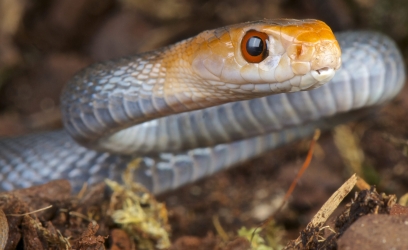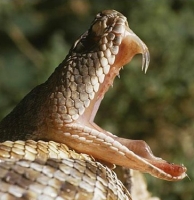  The Coastal Taipan snake is the longest venomous snake in Australia, and the third most venomous snake in the world.
A medium to large snake, with a deep, rectangular-shaped head, its body colour may be yellowish, reddish brown, dark brown or almost black.
The species undergoes a seasonal change in colour, with individuals becoming darker in winter and fading in summer. Its eyes are large, with an intense orange-brown iris and round pupil. Its average length is about 2 metres, with males being slightly larger than females.
The Coastal Taipan snake is the longest venomous snake in Australia, and the third most venomous snake in the world.
A medium to large snake, with a deep, rectangular-shaped head, its body colour may be yellowish, reddish brown, dark brown or almost black.
The species undergoes a seasonal change in colour, with individuals becoming darker in winter and fading in summer. Its eyes are large, with an intense orange-brown iris and round pupil. Its average length is about 2 metres, with males being slightly larger than females.
 Coastal Taipans have the longest fangs of all Australian snakes, up to 1.3 cm long.
Before an antidote was developed, its bite was 100% fatal. Compared to the inland taipan, the coastal taipan is a lot more aggressive and lives near people, to prey on rats and other small animals.
It shelters in abandoned animal burrows, hollow logs and piles of leaf litter. Taipans are extremely nervous snakes, and any movement near them is likely to trigger an attack. Its muscular body allows it to hurl itself forwards or sideways and reach high off the ground, and the speed of the attack means that a person may be bitten several times before realizing the snake is there.
Coastal Taipans have the longest fangs of all Australian snakes, up to 1.3 cm long.
Before an antidote was developed, its bite was 100% fatal. Compared to the inland taipan, the coastal taipan is a lot more aggressive and lives near people, to prey on rats and other small animals.
It shelters in abandoned animal burrows, hollow logs and piles of leaf litter. Taipans are extremely nervous snakes, and any movement near them is likely to trigger an attack. Its muscular body allows it to hurl itself forwards or sideways and reach high off the ground, and the speed of the attack means that a person may be bitten several times before realizing the snake is there.
Coastal Taipan venom affects the nervous system and the blood's ability to clot. Victims may experience headache, nausea/vomiting, collapse, convulsions (especially in children), paralysis, internal bleeding, destruction of muscle tissue, and kidney damage. The onset of serious symptoms is often rapid, so anyone suspected of receiving a bite must seek medical attention immediately, no matter how trivial the bite may appear. Coastal Taipans feed on warm-blooded prey, such as small mammals like mice, rats, bandicoots, and birds. When hunting, the Taipan scans for prey using its excellent eyesight, and is often seen travelling with its head raised above ground level. Once prey is detected the snake ‘freezes’ before launching itself forward and delivering one or more lightning-fast bites. The prey is released and allowed to leave; this reduces the snake’s chance of being harmed in retaliation, particularly by rats which can inflict lethal damage with their long incisors. After a few moments the Taipan tracks down the dying animal by following the scent trail with its flickering tongue. Two to three months after mating the female will lay up to 20 eggs, usually in a hollow log, under tree roots or in cavities in the ground. The eggs hatch between two and three months later. The emerging young are abount 46 cm long, and are fully equipped to hunt and begin their solitary lives. Immature snakes have a number of natural enemies, including various birds of prey. Few predators would take on a large adult Coastal Taipan, however people still routinely kill them on sight. |